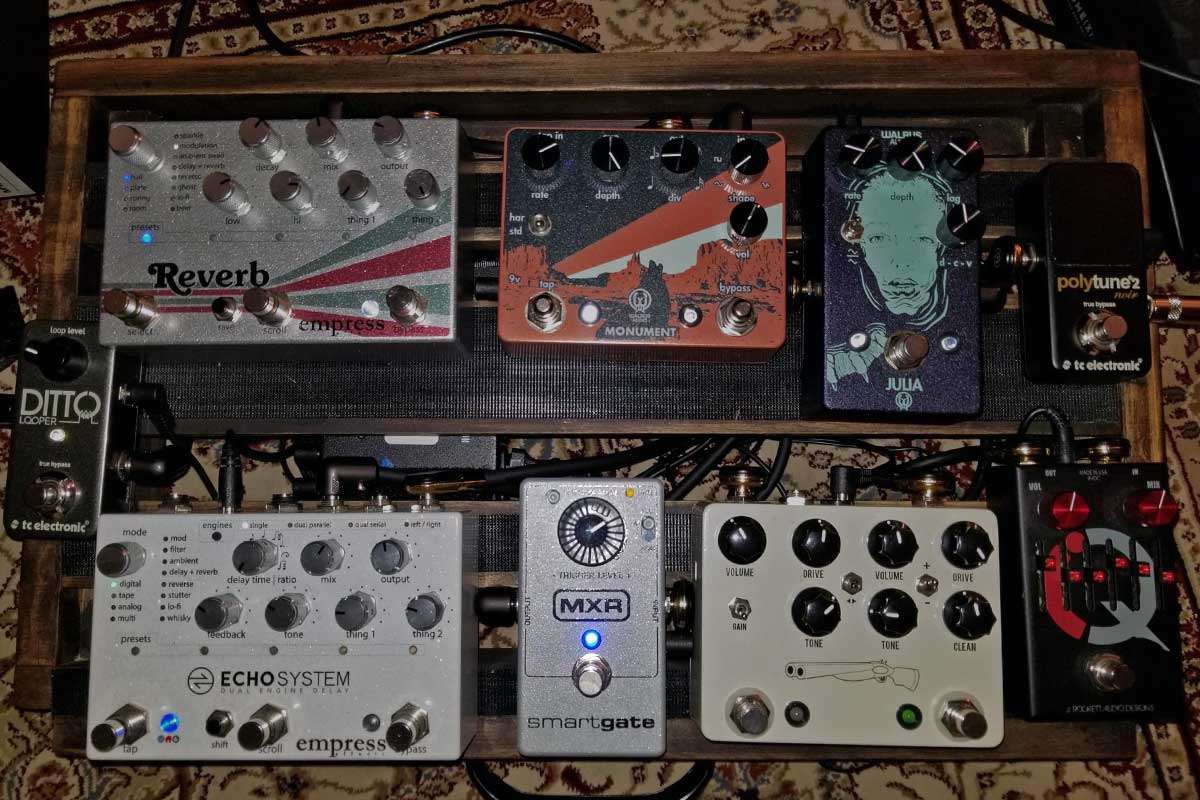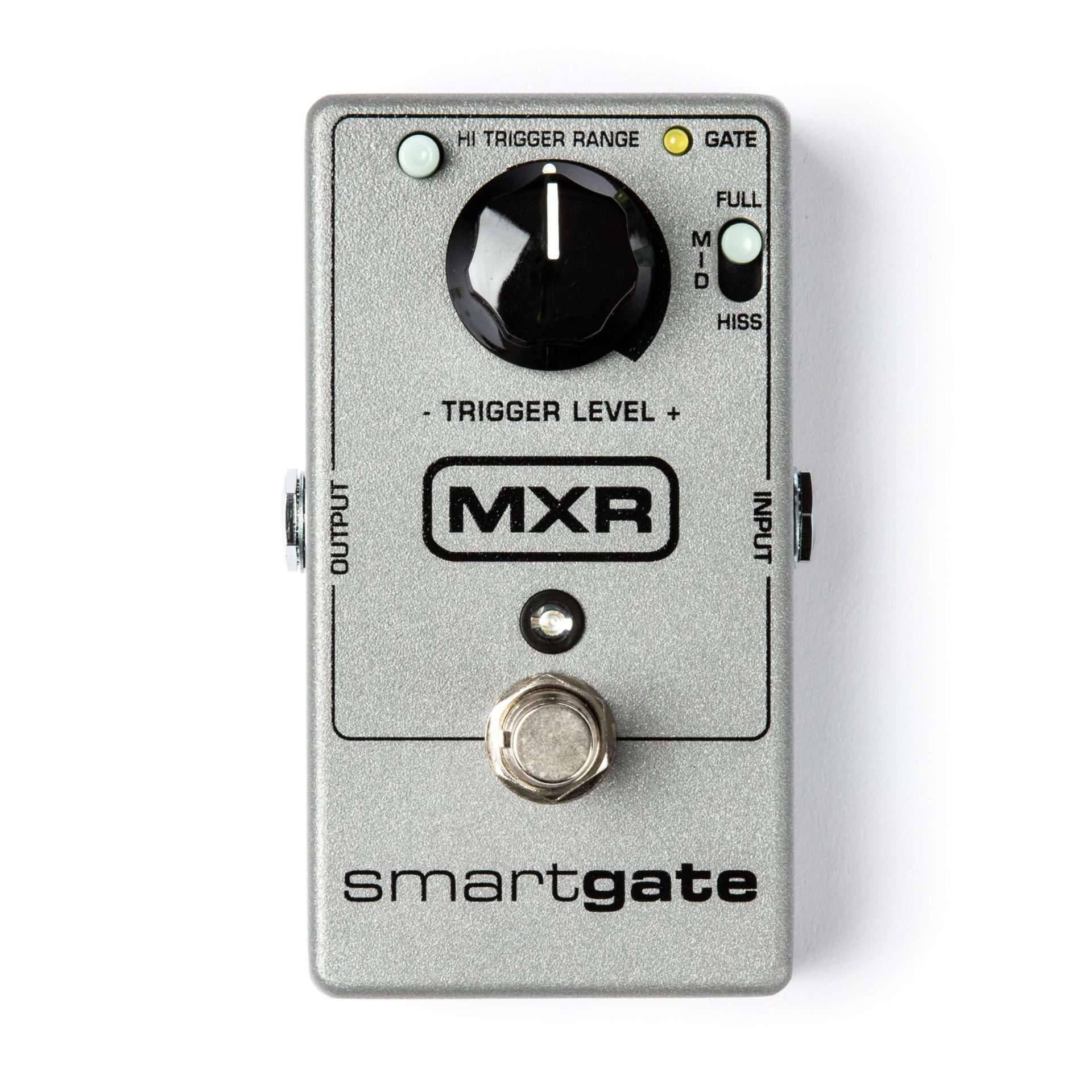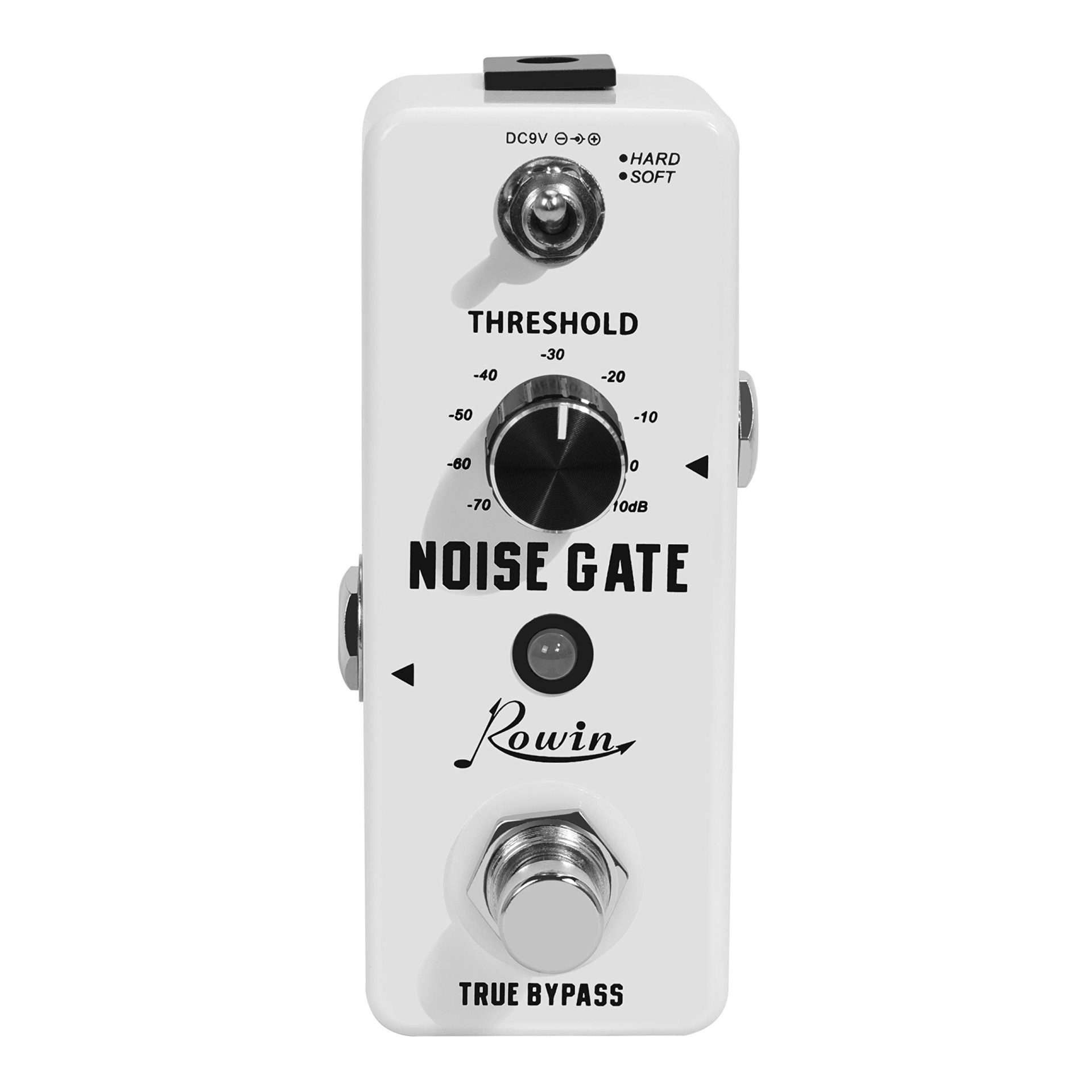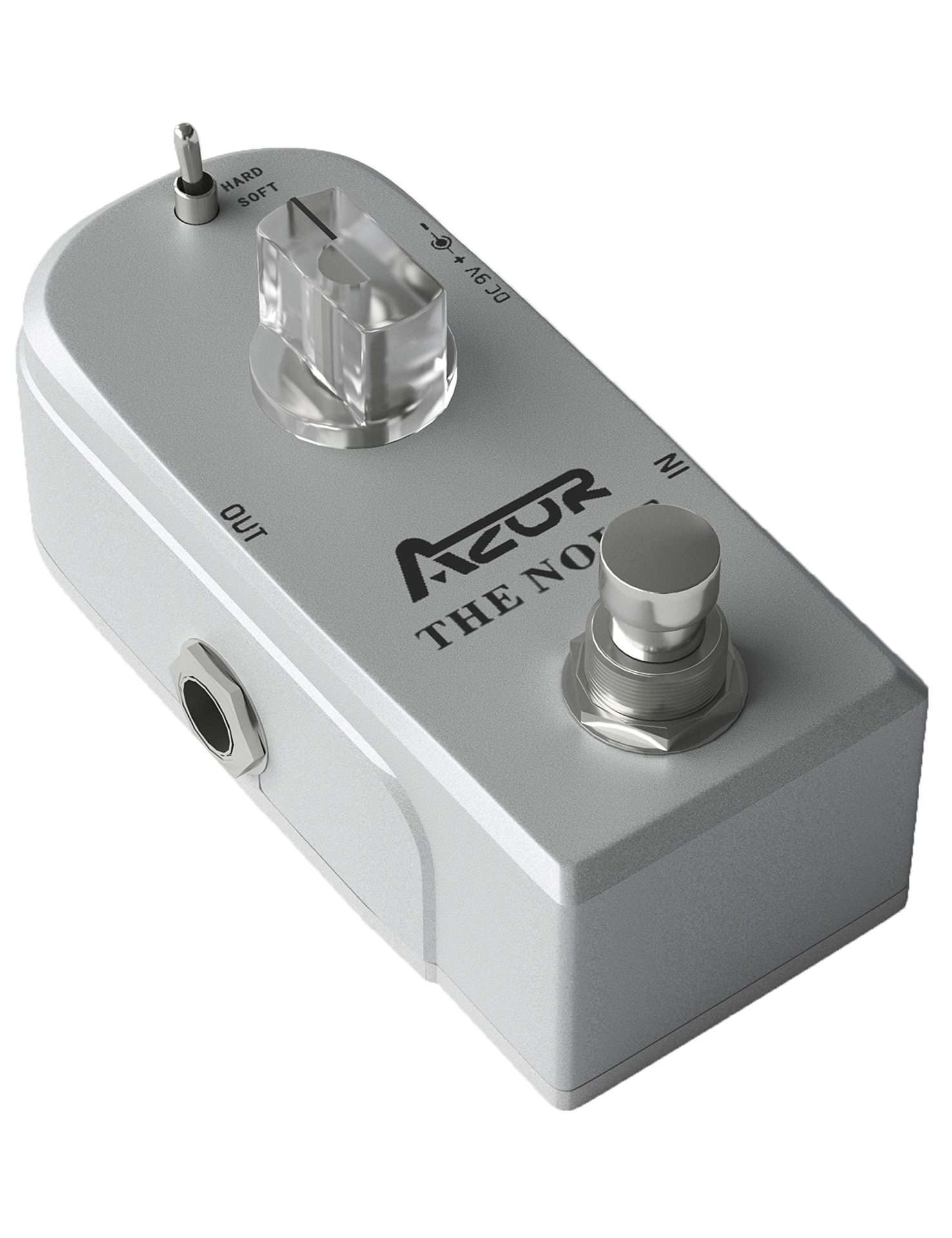In the world of electric guitars, achieving the perfect sound is an art form, and just as an artist uses various tools to create a masterpiece, guitarists use an array of pedals to craft their sound. One crucial aspect of this sound sculpting is managing and reducing unwanted noise, hum, or hiss that can clutter the clarity of the tone. Enter the noise gate pedal — a tool that has become indispensable on many pedalboards. Below are the best noise gate pedal options we’ve come across to eliminate unwanted noise & produce a more professional sound, without breaking the bank.
A noise gate pedal works by setting a threshold level that must be exceeded for sound to pass through. Sound levels below this threshold are muted, effectively “gating” the noise. For guitarists dealing with the hum from high-gain amplifiers or the electrical noise from other pedals in their signal chain, a noise gate offers a cleaner sonic palette.
When choosing the best noise gate pedal, it’s important to consider its threshold and decay controls, which dictate how abruptly the gate closes and how naturally it fades out the sound. Precision in these controls enables musicians to maintain the dynamics of their playing without sacrificing tone quality. True bypass is another feature to look for, ensuring that the pedal doesn’t color the guitar’s signal when turned off.
After rigorous testing, we’re prepared to guide you through the top picks to help you reclaim the purity of your guitar’s tone. Our hands-on experience with a variety of models will help inform your purchase, ensuring you select a noise gate pedal that meets both your performance needs and the nuances of your individual setup.

Top Noise Gate Pedals for Musicians
When seeking precision in managing unwanted noise from your signal chain, a reliable noise gate pedal is a musician’s ally. We’ve sifted through the market to bring you a selection of the best noise gate pedals that stand out for their effectiveness, build quality, and ease of use. Our picks cater to a variety of needs and budgets, ensuring there’s an option for every setup. Whether you’re playing on stage or recording in the studio, our recommendations aim to help you achieve a cleaner sound.
Jim Dunlop Smart Gate

If you’re in need of taming a noisy signal chain, the Jim Dunlop Smart Gate is an invaluable asset on stage and in the studio.
Pros
- Sensitive to playing dynamics, doesn’t stifle your expressiveness
- Three noise reduction modes for versatility
- Bypass maintains tone integrity when the gate is not needed
Cons
- Fine-tuning the threshold can take extra time
- May require battery replacement or a power supply
- Could limit some desirable noise in certain playing styles
After plugging in the Jim Dunlop Smart Gate, we noticed an immediate difference in our rig’s noise floor. The pedal attended to the hiss and hum with surgical precision, yet respected the nuances of our playing. Our leads cut through without losing sustain, revealing the Smart Gate’s intelligent engagement.
Whether on stage or laying down tracks, the noise gate proved itself as a discreet guardian of our tone. With three selectable modes, we swiftly managed different noisy environments, from taming high-gain amps to cleaning up signal chains loaded with effects.
One must be patient when finding the sweet spot for the threshold control, as precision is key to optimal performance. However, despite this learning curve, the audibly transparent bypass and reliable noise suppression made the Smart Gate a staple on our pedalboard.
TC Electronic Sentry Pedal

If you’re seeking a pristine playing experience without noise, the Sentry Noise Gate is the way to go.
Pros
- Effortlessly eliminates noise with either Multiband or Hard gate modes
- The inclusion of Send/Return enables noise reduction in pedal chains
- TonePrint offers deep customizability for signature sounds
Cons
- Encoder sensitivity might be finicky, based on external software
- Could find the accompanying manual challenging to locate
- May require patience to fully navigate and utilize TonePrint functionality
We just had a session where the Sentry really proved its worth — its noise cancellation is spot-on, pulling out unwanted hums and hisses without affecting the tone. It’s like having a personal sound engineer that knows exactly when to clean up the audio, and the Hard Gate mode is incredibly tight, totally eliminating any signal when you’re not playing.
We’ve also noticed how it streamlines our pedalboard, thanks to the Send/Return feature. It’s no longer just about what one pedal can do, but how it can take your whole setup to the next level. And when it comes to customizing sounds, the TonePrint feature lets us dive into a myriad of options, sculpting our sound with precision.
Despite its strengths, we found a little patience is needed when dealing with the TonePrint software, which we feel could be more intuitive. Moreover, tracking down the manual was more time-consuming than we’d like. However, once you’re up and running, the payoff in sonic purity and versatility is immense.
Boss NS-2 Noise Suppressor

After rigorously testing the Boss NS-2, we’ve concluded that guitarists should consider this stompbox for its effective noise suppression without tone alteration.
Pros
- Effectively eliminates unwanted noise and hum
- Preserves the natural tone and dynamics of the guitar
- User-friendly controls for precise noise gating
Cons
- May require some tweaking to find the sweet spot
- Not suitable for drastic noise issues without additional noise source management
- Can affect sustain if set improperly
As we unboxed the Boss NS-2 Noise Suppressor Pedal, its sturdy construction gave off an immediate sense of reliability. Once we plugged it in, it wasn’t long before the pedal showcased its main strength: silencing the noise. Adjusting the Threshold and Decay knobs, we shaped the sound to ensure that the pedal removed the hum without impacting our playing dynamics. During a recent jam session where we cranked up the gain, the NS-2 was a silent workhorse, keeping those pesky noises at bay.
In a live gig environment, the pedal was a lifesaver. Ambient stage noise often proves challenging, and this is where the pedal truly shone. We seamlessly integrated the NS-2 into our pedalboard and, with minimal fuss, enjoyed a cleaner sound. Whether we were dealing with single-coil hum or the buzz from an overdriven amp, the pedal addressed the issues gracefully.
Under studio conditions, we pushed the NS-2 to its limits. Some of our effects chains cause noise that could potentially ruin recordings. It becomes evident that while the NS-2 is adept at suppressing general noise, it’s not a fix-all solution. Severe noise issues might require additional measures. Also, dialing in the pedal necessitated a careful balance to maintain the quality of sustain, but once set up properly, the clarity of our recorded tracks improved significantly.
Donner Noise Killer

We think the Donner Noise Killer is a solid pick for musicians who need to maintain a clear sound without the hum and buzz from other equipment.
Pros
- Efficient noise reduction with two selectable modes
- Fast detection of noise and smooth attack/release maintains signal integrity
- True bypass ensures your guitar’s tone remains unaffected
Cons
- External power supply required; not included
- Limited to noise suppression functionality
- Bulkier than some mini pedal options
When we tried out the Donner Noise Killer, its ability to clear up unwanted noise without coloring our guitar tone made quite an impression on us. Whether we dug into aggressive riffs or let chords ring out, the pedal’s noise gate didn’t chop off the decay prematurely or hide any of the subtleties in our playing. We flipped it into hard mode during a particularly loud jam, but in softer settings, the pedal remained in the background, never stealing the show.
The true bypass was another feature we appreciated; it feels reassuring to know our signal remains pure through various pedal arrangements. After connecting our setup, all clean, there was no tonal coloration—a testament to its unobtrusive nature.
We did note the absence of a power supply, which means you’ll need to acquire one separately. The good news is that such accessories are common, and if you already have a pedalboard power supply, it should integrate without a hitch. The pedal’s singular purpose as a noise gate might seem limited compared to multi-effects units, but its mastery of this one task is undeniable. And despite being larger than a mini pedal, it found its place on our pedalboard without hassle, proving its worth during a live performance where clarity is paramount.
Rowin Noise Gate

We found that if you’re looking to minimize noise without tone loss, the Rowin Noise Killer is a reliable choice.
Pros
- Efficient noise reduction without tone degradation
- Sturdy build with a compact footprint, maximizing pedalboard space
- True bypass maintains signal integrity when disengaged
Cons
- Power supply not included; cannot be battery powered
- Some users may notice a slight tone dampening when engaged
- Limited to only two noise reduction modes
Our recent sessions were free from unwanted hiss and hum thanks to the Rowin Noise Gate. It’s built like a tank, yet its compact size doesn’t hog pedalboard real estate. The true bypass feature ensures that when the pedal’s off, your guitar’s signal remains pristine and unaffected.
The two modes offer appreciable flexibility. Whether you’re looking for aggressive noise suppression or a gentler gate for subtler noise issues, this pedal delivers. We noticed an appreciable silence between notes, bringing clarity and focus to our playing.
However, keep in mind you’ll need to pick up a separate 9V power adapter, as it doesn’t support battery operation. And while most users won’t find the tone affected, those with particularly discerning ears might pick up on a slight dampening when the noise gate is in action. Despite this, the pedal preserves the essence of your original signal admirably.
Overall, for the guitarist looking to combat noise while maintaining the essence of their tone, we’re confident in recommending the Rowin Noise Gate. It’s a small, simple solution to a common issue, providing a cleaner canvas for your musical expression.
SONICAKE Noise Wiper

If you’re facing noise troubles in your signal chain, the SONICAKE Noise Wiper is an excellent solution to consider for quieting your setup.
Pros
- Greatly reduces unwanted noise without impacting your guitar’s natural tone
- Simple one-knob operation allows for easy adjustment on the fly
- Versatile with two modes, catering to different noise reduction needs
Cons
- Lacks a power supply, which must be purchased separately
- Some may desire more control options beyond the single knob
- The compact size can be a bit fiddly on crowded pedalboards
When we introduced the SONICAKE Noise Wiper into our rig, the first thing we noticed was its remarkable capacity to maintain the integrity of our original guitar tone while it worked to eliminate excess noise. With its 100% analog design, this pedal ensured that our dynamics and tone characteristics remained unaltered, even in high-gain situations where noise typically becomes an issue.
Operation is a breeze with just a single knob to adjust the threshold of noise suppression. Whether we were looking for quick noise cuts or more gradual fades, switching between the FAST and SMOOTH modes provided the flexibility we needed for various playing styles and setups.
Despite the simplicity of the pedal, we were impressed by the true bypass feature, which allows our signal to pass through the pedal unaffected when it’s turned off. This small but robust pedal fit seamlessly into our effects chain, and we found it particularly useful for studio sessions and live performances alike.
In conclusion, the SONICAKE Noise Wiper gave us an effective and user-friendly approach to managing our sound. While we would have appreciated a few more controls for fine-tuning, and the need to buy a separate power supply is a slight inconvenience, its noise gate capabilities far outweigh these minor drawbacks.
AZOR Noise Gate Pedal

We believe the AZOR Noise Gate Pedal is a solid choice for guitarists aiming to eliminate unwanted noise without sacrificing their tone.
Pros
- Efficient noise reduction in a compact package
- Maintains the integrity of the original guitar tone
- Sturdy build with a sleek, minimalist design
Cons
- Requires an external 9V adapter, not included
- Some may find the mini size too compact for their pedalboard
- The LED indicator can be too bright for low-light environments
Playing live, one’s gear is exposed to a variety of environmental noises, which just underscores how important a reliable noise gate pedal is. The AZOR Noise Gate Pedal impresses immediately with its small footprint – it’s noticeably unobtrusive on our pedalboard. Cycling between Hard and Soft modes offers a tailored noise control that’s particularly responsive to different playing styles and setups.
The unit’s lightweight, yet the aluminum alloy chassis doesn’t skimp on durability. We’ve definitely found it convenient during gigs and practice sessions alike. When engaged, the true bypass ensures that our tone remains unaffected. It’s refreshing to stomp on a pedal that does its job without introducing any coloration or noticeable signal loss.
Understandably, not all spaces are conducive to pedalboard sprawl, which makes the minimalist format a bonus. However, we did notice that this pedal won’t run unless you have a 9V adapter, which isn’t included. This omission is something to consider for convenience’s sake. Additionally, while a non-issue for us, the ultra-compact design might be a sticking point for some, especially if you’re accustomed to larger pedals.
In spite of these considerations, the AZOR Noise Gate Pedal holds its own. It successfully performs noise suppression without altering your instrument’s character—an essential outcome for any serious musician looking for a clean sound.
Kmise Noise Gate

We found this pedal effectively tightens up our sound, giving us cleaner breaks and a more professional performance.
Pros
- Efficiently eliminates unwanted noise without affecting tone quality
- Large footswitch makes engaging/disengaging hassle-free
- True bypass ensures a pure signal path when the pedal is off
Cons
- Might require tweaking to avoid cutting off sustain prematurely
- ABS plastic construction doesn’t feel as sturdy as metal alternatives
- Some users report the need for clearer instructions
When we tested the Kmise Noise Gate pedal, the first thing we noticed was its immediacy in cutting out the noise. Our clean sections sounded crisper, which is a boon for studio work and live performance where clarity is king. The footswitch is amply sized, so there’s no fumbling around onstage – a definite plus for us gigging musicians.
The build of the pedal had us divided. While its compact design saves precious pedalboard space, the ABS plastic casing had us questioning its durability for the long haul. That doesn’t detract from its core function, but it’s something we’d keep in mind, especially when we’re on the road.
The true bypass feature gets a thumbs up from us. There’s a palpable peace of mind knowing that our tone remains uncolored when the pedal isn’t needed. However, we had to spend some time finding the sweet spot settings — too aggressive, and our sustain suffered. It’s a balancing act, but once dialed in, it performs admirably.
Overall, we see the Kmise Noise Gate as a useful tool on our pedalboard, particularly for situations that demand a pristine sound. It does its job effectively, and for anyone battling with noise issues in their signal chain, this pedal is definitely worth a try.
Buying Guide
When choosing the best noise gate pedal, it’s important to consider a few key features to ensure you get a device that meets your needs.
Threshold Control
The threshold control is critical, as it determines the level at which the gate will open to allow your signal through. Look for a noise gate pedal that offers precise threshold control, allowing you to dial in the exact point where noise is suppressed without affecting the tone.
| Feature | Purpose |
|---|---|
| Threshold | Sets the noise suppression level |
Decay Time
Decay time affects how quickly the noise gate closes after the signal drops below the threshold. Adjustable decay allows for a smoother transition that avoids cutting off notes prematurely.
| Feature | Purpose |
|---|---|
| Decay | Adjusts gate closing speed |
True Bypass
We prefer pedals with true bypass to ensure that when the noise gate is off, it doesn’t color our tone or introduce any unwanted noise into the signal chain.
| Feature | Purpose |
|---|---|
| True Bypass | Preserves true signal path |
Build Quality
The build quality is a testament to the pedal’s longevity. We look for sturdy construction that can withstand the rigors of use on stage and in the studio.
| Feature | Purpose |
|---|---|
| Build Quality | Ensures durability and reliability |
Size and Power Requirement
Consider the size of the pedal to make sure it fits on your pedalboard, and check the power requirements to ensure compatibility with your existing setup.
| Feature | Purpose |
|---|---|
| Size | Ensures fit on pedalboard |
| Power | Matches setup’s power supply |
